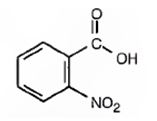
Concept explainers
Give IUPAC names for the following substances (red = O, blue = N):

a)

Interpretation:
The IUPAC name of the compound shown is to be given.
Concept introduction:
Compounds with a hydroxyl group attached to the benzene ring are named as derivatives of phenol. Substituted phenols are named using the prefixes ortho (o), meta (m) and para (p). An ortho-substituted phenol has an another substituent in a 1,2-relationship on the ring. A meta-disubstituted phenol has an another substituent in a 1,3-relationship on the ring. A para-disubstituted phenol has another substituent in a 1,4-relationship on the ring.
To give:
The IUPAC name of the compound shown.
Answer to Problem 13VC
The IUPAC name of the compound is m-isopropylphenol.
Explanation of Solution
The compound shown is

It has a hydroxyl and an isopropyl groups in the benzene ring in 1,3-relationship. Therefore its IUPAC name is m-isopropylphenol.
The IUPAC name of the compound is m-isopropylphenol.
b)

Interpretation:
The IUPAC name of the compound shown is to be given.
Concept introduction:
Compounds with a carboxyl group attached to the benzene ring are named as derivatives of benzoic acid. Substituted benzoic acids are named using the prefixes ortho (o), meta (m) and para (p). An ortho-substituted benzoic acid has an another substituent in a 1,2-relationship on the ring. A meta-disubstituted benzoic acid has an another substituent in a 1,3-relationship on the ring. A para-disubstituted benzoic acid has another substituent in a 1,4-relationship on the ring.
To give:
The IUPAC name of the compound shown.
Answer to Problem 13VC
The IUPAC name of the compound is o-nitrobenzoic acid.
Explanation of Solution
The compound shown is

It has a carboxyl group and a nitro group in the benzene ring in 1,2-relationship. Therefore its IUPAC name is o-nitrobenzoic acid.
The IUPAC name of the compound is o-nitrobenzoic acid.
Want to see more full solutions like this?
Chapter 15 Solutions
Organic Chemistry
- Rank the following groups in order of decreasing priority. −COOH, −CH2OH, −H, −CHOarrow_forwardDraw the product of the following compounds with the given image. 1. A. BH3 B. H2O2, OH- 2. A. O3 B. Z2, H2O, H+arrow_forwardGive a common name (when possible) and a systematic name for each compound. ) (h) CH3C‚CCH2OCH3arrow_forward
- Draw structures corresponding to the following IUPAC names: (a) 1, 1-Dimethylcyclooctane (b) 3-Cyclobutylhexane (c) 1, 2-Dichlorocyclopentane (d) l, 3-Dibromo-5-methylcyclohexanearrow_forwardCyclopentanecarboxylic acid and 4-hydroxycyclohexanone have the same formula (C6H10O2), and both contain an —OH and a C=O group. How could you distinguish between them using IR spectroscopy?arrow_forwardDraw and name compounds that meet the following descriptions: (a) Three acid chlorides having the formula C6H9ClO (b) Three amides having the formula C7H11NOarrow_forward
- S.3. Find the structures of the A-B-C compounds formed in the following reactions.arrow_forwardDraw the structure of two alkenes that would yield 1‑methylcyclohexanol when treated with Hg(OAc)2Hg(OAc)2 in water, then NaBH4NaBH4arrow_forwardPropose the structure of the following: a. An alkane, C6H14 b. A crylic saturated hydrocarbon, C6H12 c. A diene (dialkene), C5H8 d. A keto alkene, C5H8Oarrow_forward
- Synthesize isopropylcyclopentane from alcohols having ≤ 5 C's.arrow_forwardGive both IUPAC names and common names for the following compounds. (d) HOOCCH2CH(CH3)CO2Harrow_forwardStarting with acetylene and ethylene oxide as the only sources of carbon atoms, show how to prepare the compound Q.)1,6-Hexanediolarrow_forward

 Chemistry: An Atoms First ApproachChemistryISBN:9781305079243Author:Steven S. Zumdahl, Susan A. ZumdahlPublisher:Cengage Learning
Chemistry: An Atoms First ApproachChemistryISBN:9781305079243Author:Steven S. Zumdahl, Susan A. ZumdahlPublisher:Cengage Learning

